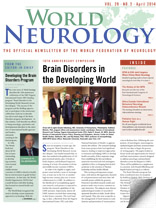
Nir Giladi
By Mark Hallett, MD
Management of patients with Parkinson’s disease has progressed well. Levodopa and the dopamine agonists are effective, and when complications arise such as dyskinesias and fluctuations, deep brain stimulation (DBS) can be effective. However, another significant problem is now emerging. That is gait difficulties later in the course of Parkinson’s disease that are not responsive to either the dopaminergic therapy or DBS. Patients can look pretty good in many ways, but will have trouble relatively isolated to balance and gait.
One interesting feature of the gait difficulty is freezing of gait (FOG). With FOG, there is a failure to move forward despite intent to do so. FOG can occur at gait onset or in the middle of walking, particularly in some settings such as walking through a doorway or turning. At times, there can be off-freezing that is dopa responsive; the problematic situation is on-freezing. FOG also occurs in other Parkinsonian conditions such as progressive supranuclear palsy.
There have been two prior workshops devoted to the topic, but recently there was an international conference Feb. 5-7, organized by Professors Nir Giladi and Jeff Hausdorff at the Dead Sea. The conference was sponsored by TelAvivUniversity, the TelAvivMedicalCenter and the International Parkinson and Movement Disorder Society. More than 160 attendees came from 20 countries.

Jeff Hausdorff
Freezing also can occur with upper extremity movements or speech, but gait is more commonly affected and more debilitating. The topic is now under intense scrutiny. Gait is a complex movement requiring integrated activity of all parts of the brain and spinal cord with both balancing and stepping. This is likely why gait is more commonly affected than other movements.
There are a number of theories as to the etiology, and, as freezing is likely to be multifactorial, many of these may well be relevant in different patients. One type of problem is the deterioration of motor control capabilities, such as loss of the internal drive for movement, difficulties with multitasking and difficulties in carrying out automatic movements. Lack of gait symmetry is often correlated with freezing.
Another interesting motor control problem in Parkinson’s disease is the sequence effect, the progressive decline of movement amplitude in a sequence of what should be similar movements. Step length often gradually declines prior to a freeze, so this seems important at least in some circumstances. Cognitive problems, importantly loss of executive function, appear relevant. There is clearly a role of environment factors, including the path that needs to be traversed; the narrow doorway, for example.
There was considerable discussion of therapy. In the end, given the multiplicity of causes, therapy may have to be individualized. Certainly, there should be care to optimize dopaminergic therapy. Physical therapy can play a role. Much discussion focused on the value of DBS of the pedunculopontine nucleus (PPN). The PPN sits in a complex region at the junction of the midbrain and the pons and appears to be a part of, or at least close to, the mesencephalic locomotor region. The literature is really still sparse, and it is not clear that the DBS electrodes are actually in the PPN in all patients, but some patients do appear improved.
Gait freezing remains an important clinical phenomenon, a fascinating set of problems for physiology and a challenge for treatment. Giladi and Hausdorff have been leaders in all aspects, and the attendees were grateful to them for organizing a useful conference that will set the direction of research in the next few years.
